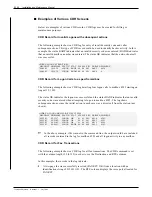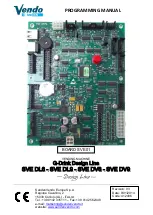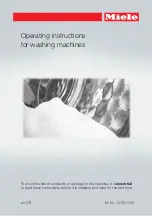
Eight CDR types are displayed at a time. To view the next group of eight, press
.
Below is an example of the first screen when all the types are viewed.
The letter X indicates that the type and status combination is enabled. A dot (.) is shown to
indicate that a type and status combination is not enabled to be logged. The transaction
types are listed in the left column and the transaction status options are listed across the top
of the screen, with status abbreviations shown vertically. For example, in column one, the
status description is OK, column two is RNA, column three BUSY, etc.
Enabling type and status combinations only determines which records should actually be
saved in the log. Some type and status combinations may not be valid, but enabling them
has no effect on the log file since they would not occur.
■
Clearing CDR for Type and Status
The type and status combinations that are logged can be changed. To clear the existing
specification, from the @ prompt, enter:
CDRENA C t s
where t is the transaction type, and s is the status value(s) to clear from that type.
A single status or a list of status values may be entered in a single command line. If a type
is specified without indicating status value(s), the system asks whether all status values are
to be included. If neither type nor status is specified, the system proceeds type by type to
ask whether all status values are to be cleared. If all status values are cleared, no records
associated with that type are logged.
Status may be partially specified. When only the first letter or two of the status is entered,
all status values beginning with the letter(s) entered are cleared. For example, if CDRENA
C NTMSGD FL is entered, the status values FLLQ, FLBU, FLRT, FLAR, FLDX, etc. are
cleared for type NTMSGD.
Enter
@CDRENA D
O R B A D D B B M G V F E B N A E F F F F F F F F F F F F F F Q N
K N U F
I I A A B R A B R L T P R L L L L L L L L L L L L L L U O
A S W R R D D X E C S R O X X R L B R A D N P N N R M U N A E C
Y D
I P M F T
Y
K F F X Q U T R K R R N C F O D D A L
CALMBX
X X X .
. . . . X X X X X X X . . . .
. . . . . . . . . . . X X X
CALATT
X . . .
. . . . X X X X X X X X X X X X X X X X X X X X X X X X .
CALPA
X X X .
. . . . . . X X . X . . . . .
. . . . . . . . . . . . . X
CALFLX
X X X X X X X X X X X X X X X X X X X X X X X X X X X X X X X X X
CALNXT
X X X X X X X X X X X X X X X X X X X X X X X X X X X X X X X X X
CALDID
. . . .
. . . . . . . . .
. . . . . .
. . . . . . . . . . . . . .
CALINT
X X X X X X X X X X X X X X X X X X X X X X X X X X X X X X X X X
QCKMSG
X X X X X X X X X X X X X X X X X X X X X X X X X X X X X X X X X
Enter
Toshiba VP Systems
Release 7.1
July, 1994
MAINTENANCE
5-131
Summary of Contents for VP 300
Page 2: ......
Page 10: ......
Page 14: ......
Page 20: ...Toshiba VP Systems Release 7 1 July 1994 ...
Page 52: ...Toshiba VP Systems Release 6 1 February 1993 2 14 Installation and Maintenance Manual ...
Page 56: ...Toshiba VP Systems Release 7 1 July 1994 ...
Page 146: ......
Page 312: ...Toshiba VP Systems Release 7 1 July 1994 ...
Page 314: ......
Page 444: ......
Page 496: ......
Page 542: ......
Page 598: ...Toshiba VP Systems Release 6 1 February 1993 ...
Page 600: ...Toshiba VP Systems Release 6 1 February 1993 ...
















































